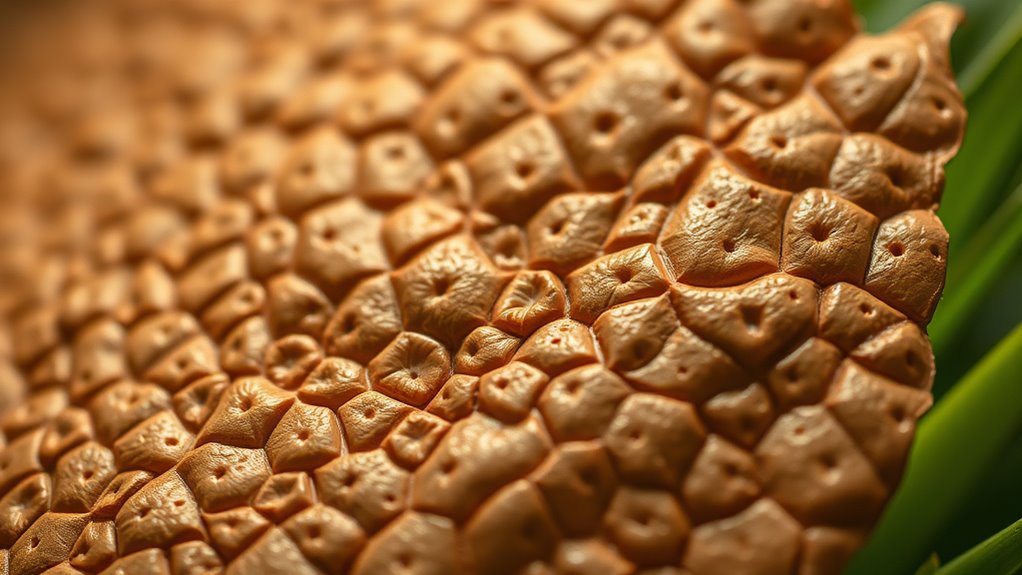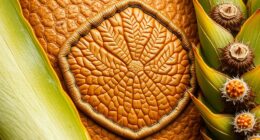Plant-based leathers made from fungi and pineapples are transforming fashion by providing eco-friendly, cruelty-free options that don’t compromise on style or quality. Fungi leather, grown from mushroom root structures, uses less land, water, and energy, making it a sustainable alternative to traditional leather. Pineapple fibers, a byproduct of fruit harvesting, add natural texture and reduce waste. These innovative materials are helping brands create stylish, environmentally conscious products—stay with us to explore more about this exciting shift.
Key Takeaways
- Fungi-based leather (mycelium) offers a sustainable, biodegradable alternative that resembles traditional leather in texture and durability.
- Pineapple leather (Piñatex) utilizes agricultural waste, reducing environmental impact and adding value to discarded pineapple leaves.
- Both materials significantly lower resource use, including water and land, compared to conventional animal leather production.
- These plant-based leathers meet consumer demand for eco-friendly, cruelty-free, and stylish fashion options.
- Their growing adoption is shaping a more sustainable future in the fashion industry.

Have you ever wondered if there’s a sustainable alternative to traditional leather? If so, you’re not alone. As more people become conscious of their environmental impact, sustainable materials are gaining popularity in eco friendly fashion. Plant-based leather offers a promising solution that reduces the reliance on animal hides and minimizes environmental damage. Unlike conventional leather, which involves resource-intensive tanning processes and significant water usage, plant-based options are designed to be more eco-friendly, harnessing natural ingredients to create durable, stylish products. This shift is driven by a desire to make fashion more sustainable without sacrificing quality or aesthetics.
Discover sustainable, plant-based leather options that reduce environmental impact without sacrificing style or quality.
Fungi and pineapples are at the forefront of this innovative movement, transforming the way we think about material sourcing. Fungi-based leather, often called mycelium leather, is made from the root-like structures of mushrooms. It’s grown in controlled environments, requiring less land, water, and energy compared to traditional leather production. The result is a material that looks and feels remarkably similar to animal leather, but with a much smaller environmental footprint. Additionally, fungi-based leather is biodegradable, which helps reduce long-term waste.
By using fungi, designers and brands can produce high-quality, cruelty-free products that appeal to eco conscious consumers. Not only is it a sustainable material, but it’s also biodegradable, which means it won’t contribute to long-term waste in landfills.
Meanwhile, pineapple leather, also known as Piñatex, is created from the fibers of pineapple leaves—a byproduct of the fruit harvest. This approach not only makes use of what would otherwise be discarded, but it also provides farmers with an additional income stream. The process involves extracting the fibers, treating them, and then weaving them into a durable material suitable for shoes, bags, and apparel.
Pineapple leather offers a natural, textured look that adds a distinctive aesthetic to fashion pieces. As a sustainable material, it helps reduce reliance on synthetic alternatives, which often involve plastics and other chemicals harmful to the environment.
Both fungi and pineapple-based leathers exemplify how innovation can align with eco friendly fashion goals. They demonstrate that sustainable materials can be stylish, functional, and environmentally responsible. As these plant-based leathers grow in popularity, more brands are adopting them to meet consumer demand for ethically produced, eco-conscious products.
They’re paving the way for a future where fashion isn’t just about appearance but also about making a positive impact on the planet. If you’re passionate about sustainability, exploring plant-based leather options is a step toward supporting a more responsible and greener industry. Incorporating biodegradable materials like fungi leather helps ensure that fashion choices contribute to a healthier environment rather than long-term waste.
Frequently Asked Questions
What Environmental Benefits Do Fungi and Pineapple Leathers Offer?
You’ll find that fungi and pineapple leathers considerably benefit the environment. They promote sustainable farming by requiring less water and land compared to traditional leather, reducing resource depletion.
Plus, they help preserve biodiversity by utilizing waste materials and encouraging eco-friendly practices. Choosing these materials minimizes pollution and lowers greenhouse gas emissions, making fashion more eco-conscious.
Are Plant-Based Leathers as Durable as Traditional Leather?
Think of plant-based leather as a new contender in the ring. Durability comparisons show it’s improving but may not yet match traditional leather’s strength and longevity.
You’ll find that maintenance requirements are generally lower and easier, making it a practical choice.
While it may not yet fully rival traditional leather in toughness, advances are closing the gap, offering a sustainable option that can last if cared for properly.
How Do Fungi and Pineapple Leathers Impact Local Economies?
You see, fungi and pineapple leathers boost local economies by promoting local job creation, especially in agriculture and manufacturing sectors.
When communities embrace these sustainable materials, they experience regional economic growth through new businesses and increased demand for raw materials.
This shift not only supports farmers and artisans but also encourages innovation, helping regions thrive economically while reducing environmental impacts.
Your support can help these eco-friendly industries flourish.
Can Plant-Based Leather Be Recycled or Biodegradable?
You might wonder if plant-based leather can be recycled or biodegraded. Many options have high biodegradability potential, meaning they break down naturally over time.
Recycling processes are evolving to handle plant-based materials, making them more sustainable. While some plant leathers are biodegradable, others require specific conditions for breakdown.
What Are the Cost Differences Between Plant-Based and Traditional Leather?
They say, “You get what you pay for,” and that’s true with leather prices. Plant-based leather often costs more upfront due to newer technology and materials, but it can vary widely depending on the brand, quality, and scale.
The cost comparison with traditional leather shows price variability, with some plant-based options being more affordable and others pricier. Overall, investing in plant-based leather can be a greener choice, despite initial costs.
Conclusion
As you explore plant-based leathers made from fungi and pineapples, you’ll see how they’re revolutionizing fashion’s sustainability. These innovative materials reduce environmental impact—up to 80% less water usage compared to traditional leather. By choosing eco-friendly options, you’re helping cut down on pollution and deforestation. With more brands adopting these alternatives, you’re part of a movement that’s shaping a greener, more ethical industry, proving that stylish can also mean sustainable.









